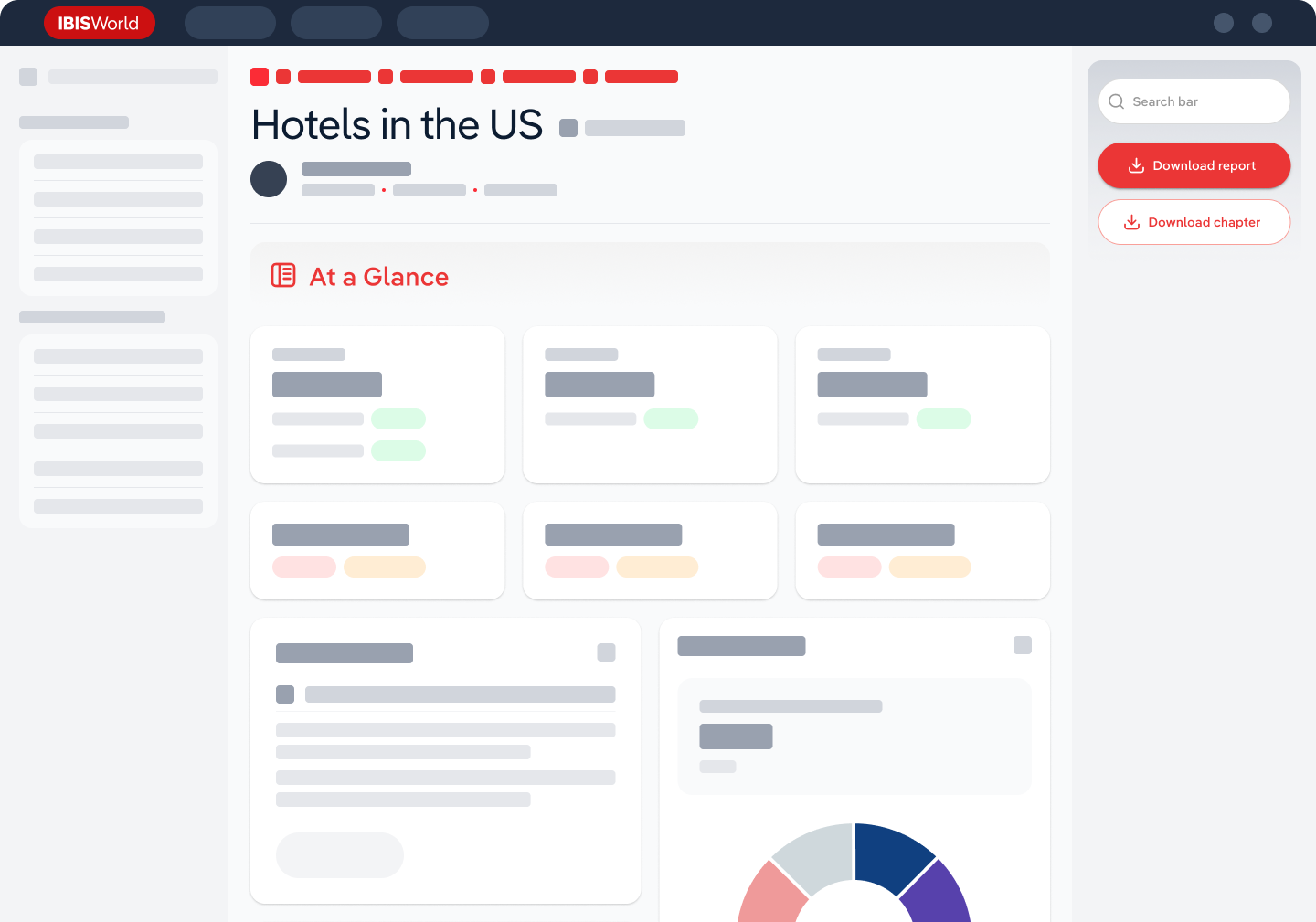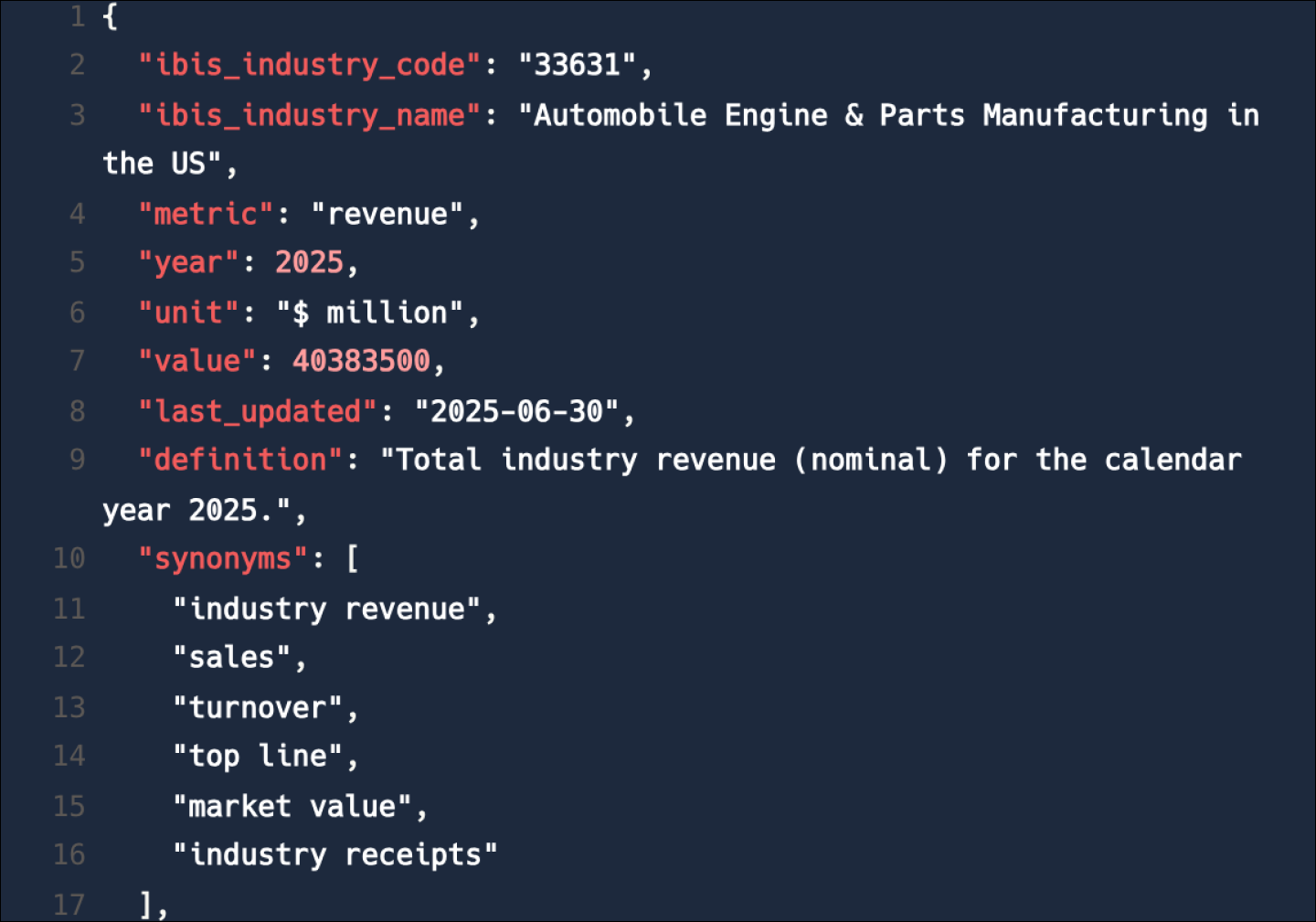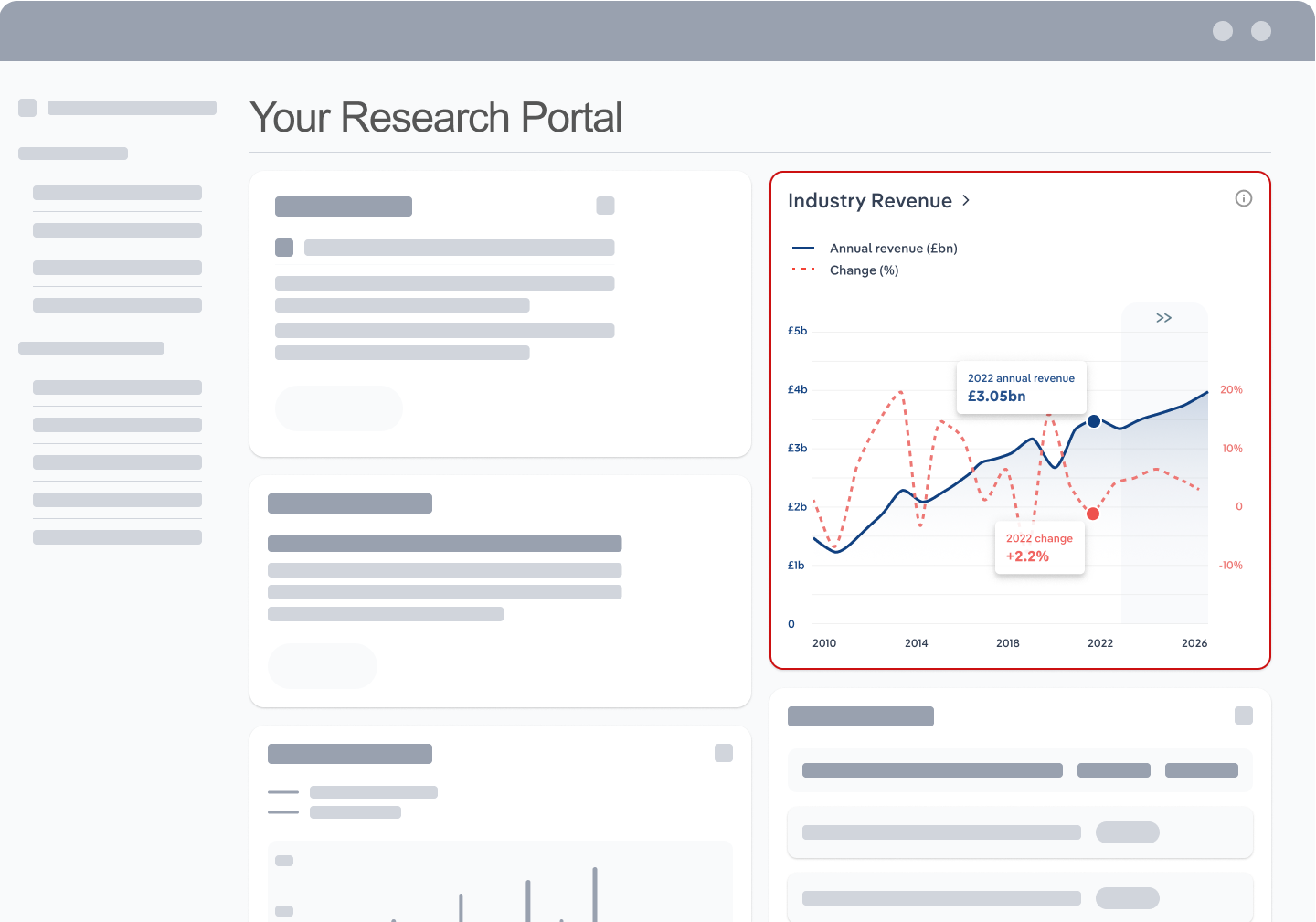Industry Statistics and Trends
Market size and recent performance (2015-2030)
Industry revenue has grown at a CAGR of 1.9 % over the past five years, to reach an estimated $13.7bn in 2025.
Trends and Insights
Demand from oil and gas extraction and mining
- Demand for equipment from oil and gas extraction and mining is largely determined by commodity prices.
- Additional trends and insights available with purchase
Industry outlook (2025-2030)
Trends and Insights
Normalizing demand for gas, oil and other commodities
- Over the next few years, demand conditions for gas, oil and other commodities produced downstream of this industry are expected to largely revert to pre-pandemic norms, resulting in mild growth.
Biggest companies in the Mining, Oil & Gas Machinery Wholesaling in Canada
| Company | Market Share (%)
2025 | Revenue ($m)
2025 | Profit ($m)
2025 | Profit Margin (%)
2025 |
|---|
There are no companies that hold a market share exceeding 5% in the Mining, Oil & Gas Machinery Wholesaling in Canada industry.
Products & Services Segmentation
Industry revenue is measured across several distinct product and services lines, including Mining machinery and equipment manufacturing, Rotary oil and gas field drilling machinery and equipment and Oil and gas field production machinery and equipment. Mining machinery and equipment manufacturing is the largest segment of the Mining, Oil & Gas Machinery Wholesaling in Canada.
Trends and Insights
Oil prices impact rotary oil and gas field drilling machinery and equipment sales
- The oil and gas machinery and equipment segment includes rotary and portable drilling rigs, derricks, substructures and other accessories.
- More insights available in the full report
Table of Contents
About this industry
Industry definition
The Mining, Oil and Gas Machinery Wholesaling industry in Canada comprises operators primarily engaged in wholesaling new and used mining, oil and gas equipment, as well as machinery. This industry does not include wholesalers of pumps, oil refining equipment or pipeline equipment, which are included in the Industrial Machinery and Equipment Wholesaling industry in Canada (IBISWorld report 41723CA).
What's included in this industry?
Products and services covered in the Mining, Oil & Gas Machinery Wholesaling industry in Canada include Wholesaling agitators, crushers and classifiers, Wholesaling ball, rod and pebble mill machinery, Wholesaling floating roof seals for oil and gas storage tanks, Wholesaling natural gas field production equipment, Wholesaling oil well machinery and equipment, Wholesaling petroleum production machinery and equipment, Wholesaling vibrating and screening equipment and Wholesaling ore dressing machinery.Companies
Companies covered in the Mining, Oil & Gas Machinery Wholesaling industry in Canada include .Purchase this report to view all major companies in this industry.
Related Terms
Related terms covered in the Mining, Oil & Gas Machinery Wholesaling industry in Canada include ore dressing, classifier, continuous mining machine, excavator and beneficiation.Industry Code
NAICS 417220 - Mining, Oil & Gas Machinery Wholesaling in Canada
Performance
Get an indication of the industry's health through historical, current and forward-looking trends in the performance indicators that make or break businesses.
Analyst insights
Gas and oil prices saw strong growth following the COVID-19 pandemic. High prices allow gas and oil producers to invest in equipment from wholesalers.
In this chapter (4)
- Current Performance
- Outlook
- Volatility
- Life Cycle
Key metrics
- Annual Revenue, Recent Growth, Forecast, Revenue Volatility
- Number of Employees, Recent Growth, Forecast, Employees per Business, Revenue per Employee
- Number of Businesses, Recent Growth, Forecast, Employees per Business, Revenue per Business
- Total Profit, Profit Margin, Profit per Business
Charts
- Revenue, including historical (2015-2024) and forecast (2025-2030)
- Employees, including historical (2015-2024) and forecast (2025-2030)
- Businesses, including historical (2015-2024) and forecast (2025-2030)
- Profit, including historical (2015-2025)
- Industry Volatility vs. Revenue Growth
- Industry Life Cycle
Detailed analysis
- Trends in supply, demand and current events that are driving current industry performance
- Expected trends, economic factors and ongoing events that drive the industry's outlook
- Key success factors for businesses to overcome volatility
- How contribution to GDP, industry saturation, innovation, consolidation, and technology and systems influence the industry's life cycle phase.
Products and Markets
Learn about an industry's products and services, markets and trends in international trade.
Analyst insight
Oil and gas field operators comprise the industry's largest downstream major market segment. Companies in this market segment purchase drills, portable drilling rigs, derrick...
In this chapter
- Products & Services
- Major Markets
Key metrics
- Largest market segment and value in 2025
- Product innovation level
Charts
- Products & services segmentation in 2025
- Major market segmentation in 2025
Detailed analysis
- Trends impacting the recent performance of the industry's various segments
- Innovations in the industry's product or service offering, specialization or delivery method
- Key factors that successful businesses consider in their offerings
- Buying segments and key trends influencing demand for industry products and services
Geographic Breakdown
Discover where business activity is most concentrated in an industry and the factors driving these trends to find opportunities and conduct regional benchmarking.
Analyst insights
Alberta dominates the industry. As most of Canada’s oil production takes place in Alberta, equipment wholesalers locate close to the region.
In this chapter (1)
- Business Locations
Charts
- Share of revenue, establishment, wages and employment in each province
- Share of population compared to establishments in each region in 2025
Tables
- Number and share of establishments in each province in 2025
- Number and share of revenue each province accounts for in 2025
- Number and share of wages each province accounts for in 2025
- Number and share of employees in each province in 2025
Detailed analysis
- Geographic spread of the industry across North America, and trends associated with changes in the business landscape
- Key success factors for businesses to use location to their advantage
Competitive Forces
Get data and insights on what's driving competition in an industry and the challenges industry operators and new entrants may face, with analysis built around Porter's Five Forces framework.
Analyst insights
Exclusive distribution rights to a brand of equipment over a specific geographic locale can give wholesalers an advantage over competitors.
In this chapter (4)
- Concentration
- Barriers to Entry
- Substitutes
- Buyer & Supplier Analysis
Key metrics
- Industry concentration level
- Industry competition level and trend
- Barriers to entry level and trend
- Substitutes level and trend
- Buyer power level and trend
- Supplier power level and trend
Charts
- Market share concentration among the top 4 suppliers from 2020-2025
- Supply chain including upstream supplying industries and downstream buying industries, flow chart
Detailed analysis
- Factors impacting the industry’s level of concentration, such as business distribution, new entrants, or merger and acquisition activity.
- Key success factors for businesses to manage the competitive environment of the industry.
- Challenges that potential industry entrants face such as legal, start-up costs, differentiation, labor/capital intensity and capital expenses.
- Key success factors for potential entrants to overcome barriers to entry.
- Competitive threats from potential substitutes for the industry’s own products and services.
- Key success factors for how successful businesses can compete with substitutes.
- Advantages that buyers have to keep favorable purchasing conditions.
- Advantages that suppliers have to maintain favorable selling conditions.
- Key success factors for how businesses can navigate buyer and supplier power.
Companies
There are no companies that hold a market share exceeding 5% in the Mining, Oil & Gas Machinery Wholesaling in Canada industry.
Analyst insights
No company controls more than 5.0% of the market. High fragmentation is a result of low barriers to entry, constantly allowing new entrants.
External Environment
Understand the demographic, economic and regulatory factors that shape how businesses in an industry perform.
Analyst insights
Maintaining an extensive operation is key to avoiding direct-to-manufacturer sales. Fast customer service gives wholesalers a unique advantage and justifies slightly higher p...
In this chapter
- External Drivers
- Regulation & Policy
- Assistance
Key metrics
- Regulation & policy level and trend
- Assistance level and trend
Charts
- Regulation & Policy historical data and forecast (2015-2030)
- Assistance historical data and forecast (2015-2030)
Detailed analysis
- Demographic and macroeconomic factors influencing the industry, including Regulation & Policy and Assistance
- Major types of regulations, regulatory bodies, industry standards or specific regulations impacting requirements for industry operators
- Key governmental and non-governmental groups or policies that may provide some relief for industry operators.
Financial Benchmarks
View average costs for industry operators and compare financial data against an industry's financial benchmarks over time.
Analyst insights
Highly skilled salespeople are required to maintain relationships with suppliers and buyers, securing revenue streams, but also cutting into profit margins.
In this chapter
- Cost Structure
- Financial Ratios
- Key Ratios
Key metrics
- Profit margin, and how it compares to the sector-wide margin
- Average wages, and how it compares to the sector-wide average wage
- Largest cost component as a percentage of revenue
- Industry average ratios for days' receivables, industry coverage and debt-to-net-worth ratio
Charts
- Average industry operating costs as a share of revenue, including purchases, wages, depreciation, utilities, rent, other costs and profit in 2025
- Average sector operating costs as a share of revenue, including purchases, wages, depreciation, utilities, rent, other costs and profit in 2025
- Investment vs. share of economy
Data tables
- Liquidity Ratios (2018-2023)
- Coverage Ratios (2018-2023)
- Leverage Ratios (2018-2023)
- Operating Ratios (2018-2023)
- Assets (2018-2023)
- Liabilities (2018-2023)
- Cash Flow & Debt Service Ratios (2015-2030)
- Revenue per Employee (2015-2030)
- Revenue per Enterprise (2015-2030)
- Employees per Establishment (2015-2030)
- Employees per Enterprise (2015-2030)
- Average Wage (2015-2030)
- Wages/Revenue (2015-2030)
- Establishments per Enterprise (2015-2030)
- IVA/Revenue (2015-2030)
- Imports/Demand (2015-2030)
- Exports/Revenue (2015-2030)
Detailed analysis
- Trends in the cost component for industry operators and their impact on industry costs and profitability
Key Statistics
Industry Data
Data Tables
Including values and annual change:
- Revenue (2015-2030)
- IVA (2015-2030)
- Establishments (2015-2030)
- Enterprises (2015-2030)
- Employment (2015-2030)
- Exports (2015-2030)
- Imports (2015-2030)
- Wages (2015-2030)
Top Questions Answered
Unlock comprehensive answers and precise data upon purchase. View purchase options.
What is the market size of the Mining, Oil & Gas Machinery Wholesaling industry in Canada in 2025?
The market size of the Mining, Oil & Gas Machinery Wholesaling industry in Canada is $13.7bn in 2025.
How many businesses are there in the Mining, Oil & Gas Machinery Wholesaling industry in Canada in 2025?
There are 539 businesses in the Mining, Oil & Gas Machinery Wholesaling industry in Canada, which has declined at a CAGR of 3.3 % between 2020 and 2025.
How may import tariffs affect the Mining, Oil & Gas Machinery Wholesaling industry in Canada?
The Mining, Oil & Gas Machinery Wholesaling industry in Canada is unlikely to be materially impacted by import tariffs with imports accounting for a low share of industry revenue.
How may export tariffs affect the Mining, Oil & Gas Machinery Wholesaling industry in Canada?
The Mining, Oil & Gas Machinery Wholesaling industry in Canada is unlikely to be materially impacted by export tariffs with exports accounting for a low share of industry revenue.
Has the Mining, Oil & Gas Machinery Wholesaling industry in Canada grown or declined over the past 5 years?
The market size of the Mining, Oil & Gas Machinery Wholesaling industry in Canada has been growing at a CAGR of 1.9 % between 2020 and 2025.
What does the Mining, Oil & Gas Machinery Wholesaling industry in Canada include?
Wholesaling agitators, crushers and classifiers and Wholesaling ball, rod and pebble mill machinery are part of the Mining, Oil & Gas Machinery Wholesaling industry in Canada.
How competitive is the Mining, Oil & Gas Machinery Wholesaling industry in Canada?
The level of competition is moderate and steady in the Mining, Oil & Gas Machinery Wholesaling industry in Canada.
Methodology
How are IBISWorld reports created?
IBISWorld has been a leading provider of trusted industry research for over 50 years to the most successful companies worldwide. With offices in Australia, the United States, the United Kingdom, Germany and China, we are proud to have local teams of analysts that conduct research, data analysis and forecasting to produce data-driven industry reports.
Our analysts start with official, verified and publicly available sources of data to build the most accurate picture of each industry. Analysts then leverage their expertise and knowledge of the local markets to synthesize trends into digestible content for IBISWorld readers. Finally, each report is reviewed by one of IBISWorld’s editors, who provide quality assurance to ensure accuracy and readability.
IBISWorld relies on human-verified data and human-written analysis to compile each standard industry report. We do not use generative AI tools to write insights, although members can choose to leverage AI-based tools within the platform to generate additional analysis formats.
What data sources do IBISWorld analysts use?
Each industry report incorporates data and research from government databases, industry-specific sources, industry contacts, and our own proprietary database of statistics and analysis to provide balanced, independent and accurate insights.
Key data sources in Canada include:
- Statistics Canada
- Industry Canada
- Canadian Business Patterns
Analysts also use industry specific sources to complement catch-all sources, although their perspective may focus on a particular organization or representative body, rather than a clear overview of all industry operations. However, when balanced against other perspectives, industry-specific sources provide insights into industry trends.
These sources include:
- Industry and trade associations
- Industry federations or regulators
- Major industry players annual or quarterly filings
Finally, IBISWorld’s global data scientists maintain a proprietary database of macroeconomic and demand drivers, which our analysts use to help inform industry data and trends. They also maintain a database of statistics and analysis on thousands of industries, which has been built over our more than 50-year history and offers comprehensive insights into long-term trends.
How does IBISWorld forecast its data?
IBISWorld’s analysts and data scientists use the sources above to create forecasts for our proprietary datasets and industry statistics. Depending on the dataset, they may use regression analysis, multivariate analysis, time-series analysis or exponential smoothing techniques to project future data for the industry or driver. Additionally, analysts will leverage their local knowledge of industry operating and regulatory conditions to impart their best judgment on the forecast model.
IBISWorld prides itself on being a trusted, independent source of data, with over 50 years of experience building and maintaining rich datasets and forecasting tools. We are proud to be the keystone source of industry information for thousands of companies across the world.
Learn more about our methodology and data sourcing on the Help Center.










